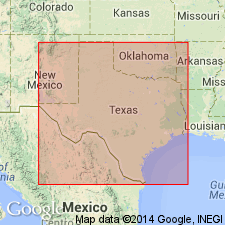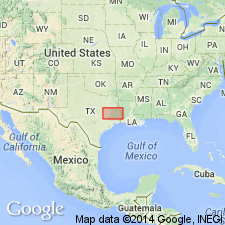
- Usage in publication:
-
- Onalaska clays
- Modifications:
-
- Original reference
- Dominant lithology:
-
- Sand
- Clay
- AAPG geologic province:
-
- Gulf Coast basin
Summary:
Pg. 466. Onalaska clays. Transitional zone in the Corrigan in which the sands of the Corrigan are interbedded with calcareous clays similar to those of overlying Fleming. On this account the limit is not as well defined as farther east, and upper line is drawn where the sands with porcelaneous cement cease and the clays weather entirely dark brown or black, instead of showing the characteristic yellow weathering of Corrigan clays. These upper beds maintain their character and thickness as far west as Navasota River, eastern Texas. While they appear later than Catahoula proper, they are definitely connected with it by character of the sands and clays of which they are composed. Assigned to upper Oligocene.
Source: US geologic names lexicon (USGS Bull. 896, p. 1547).

- Usage in publication:
-
- Onalaska beds
- Modifications:
-
- Age modified
- AAPG geologic province:
-
- Gulf Coast basin
Summary:
Pg. 29, 189-218. Onalaska beds, at top of Corrigan formation, are assigned to upper Oligocene and possiblly Miocene in upper part. Recognized in eastern Texas.
[GNC remark (ca. 1936, US geologic names lexicon, USGS Bull. 896, p. 1547): The Catahoula sandstone is now considered to be probably Miocene, so that this overlying clay cannot be Oligocene. Age is Miocene.]
Source: US geologic names lexicon (USGS Bull. 896, p. 1547).

- Usage in publication:
-
- Onalaska member
- Modifications:
-
- Principal reference
- Revised
- AAPG geologic province:
-
- Gulf Coast basin
Summary:
Pg. 530 (chart), 715, 717 (fig. 48). Onalaska member of Catahoula formation. Catahoula in east Texas divided into Onalaska above and Chita member (new) below. Dumble gave name Onalaska to strata above his basal sandstone member (now called Chita) and below base of Fleming (now called Lagarto and Oakville). Beds consist of tuffaceous shales, sandy clays, and cross-bedded lenticular sandstones in places cemented opal. Type locality stated. Chart, p. 30, shows Onalaska member; fig. 48 shows Onalaska tuff.
Type locality: exposures in Rocky Creek, east of Onalaska, Polk Co., eastern TX.
Source: US geologic names lexicon (USGS Bull. 896, p. 2827).
For more information, please contact Nancy Stamm, Geologic Names Committee Secretary.
Asterisk (*) indicates published by U.S. Geological Survey authors.
"No current usage" (†) implies that a name has been abandoned or has fallen into disuse. Former usage and, if known, replacement name given in parentheses ( ).
Slash (/) indicates name conflicts with nomenclatural guidelines (CSN, 1933; ACSN, 1961, 1970; NACSN, 1983, 2005, 2021). May be explained within brackets ([ ]).

